QANTAS B747-400 COCKPIT FAMILIARIZATION
ECLIPSE / NAVIGATOR'S WINDOW
Glenn Schneider, 18 December 2002 (photos by J. Moskowitz during our
meeting
with Cpt. John Black)
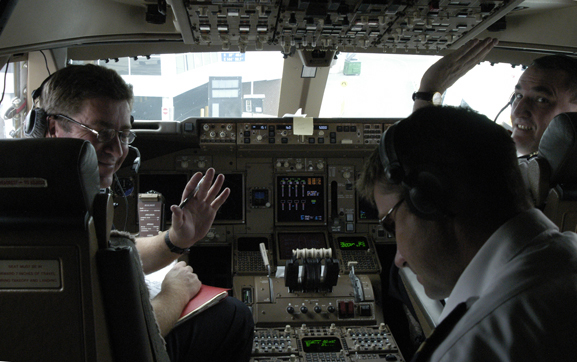
View forward from the navigation seat. The eclipse will be viewed
on the port (left) side windows facing forward.
| The Window
Three views of the navigation seat window which will be
used for eclipse observation/photography. This is a high quality,
but multiple-layer, window measures appx. 16" x 28" (exact specification
forthcoming).
Bottom left shows full extent of window from navigation
seat but with the pilot's seat in its full back position. The window
is (conveniently) sloped upward at an angle approximately equal to the
altitude of the eclipse above the horizon at the intercepts under consideration.
Bottom right with the pilot's seat move partially forward.
Top right with a standard "cubit" measure for size reference. |

|
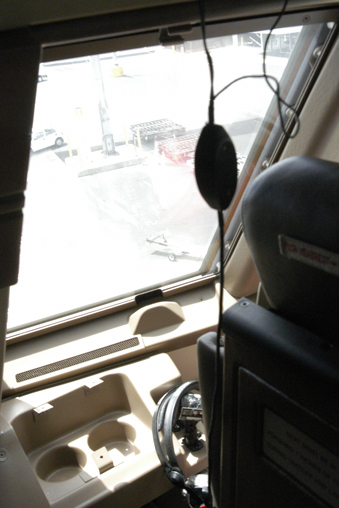
|
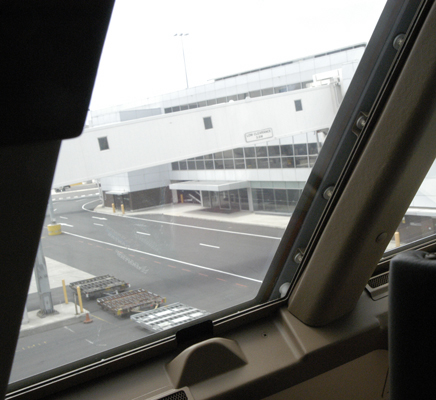
|
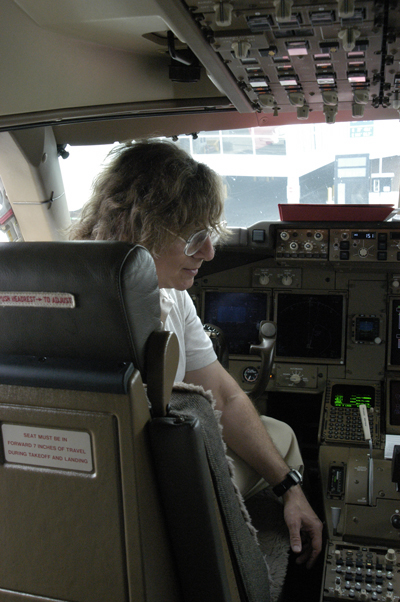 |
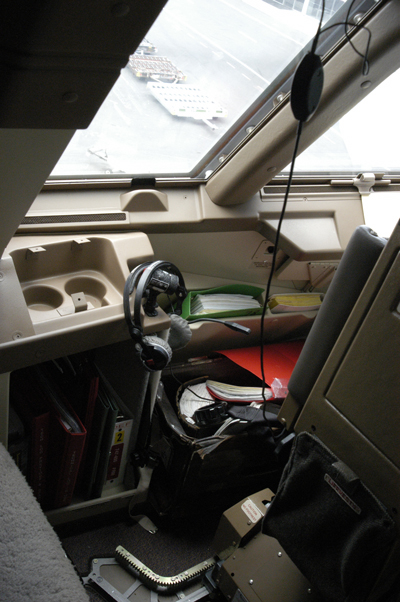 |
With the pilot's seat move forward (left), and still in a configuration
in which the aircraft can be flown, there is a substantial amount of free
"floor" space in front of the navigation seat (the bottom cushion of which
is just visible on the lower left of the frame to the right).
The geared track on the floor is part of the seat-rail system for the pilot's
seat. In this photo there is a fair amount of "clutter" with documents
in a bin to the left and behind the pilot's seat, which can be removed
for the eclipse flight to give better access to the window.
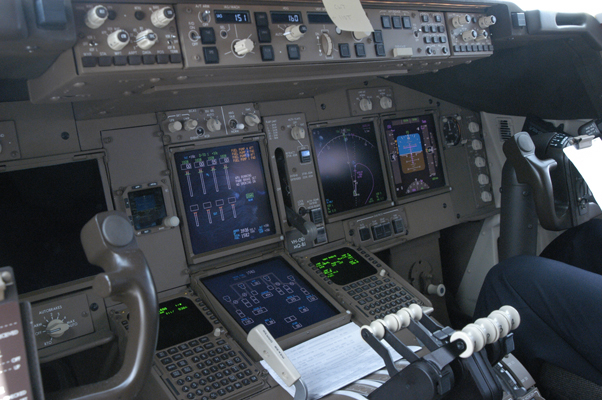
Multi-function avionics, engineering, and navigation panels and displays
through which EFLIGHT data will be keyed in.
Click HERE for a more detailed
view of the key pads and displays.
Glenn Schneider / EFLIGHT
/ HOME PAGE / UMBRAPHILLIA
/ UMBRAPHILE
/ email
Subject: [SE] TSE 2003 CROYDON FLIGHT: Meetings/Discussions
with Phil Asker & QA Pilots
Date: Wed, 11 Dec 2002 22:45:56 -0700
From: Glenn Schneider <gschneider@mac.com>
Reply-To: SOLARECLIPSES@AULA.COM
Organization: Steward Observatory
To: SOLARECLIPSES@AULA.COM, phil.asker@croydontravel.com.au, funta@ozemail.com.au
See: http://nicmosis.as.arizona.edu:8000/ECLIPSE_WEB/ECLIPSE_03/CROYDON_ECLIPSE.html
On Saturday, 8 Decmber 2002, after arriving in Melbourne, Australia,
I had a very positive and productive meeting with Phil Asker of Croydon
travel (with Joel Moskowitz in attendance) regarding the now-solicited
Antarctic "sightseeing/eclipse" flight using a QANTAS B747-400. Many on
SEML (and also many who have already signed up for this flight) have expressed
concerns regarding the conduction of that flight as being suitable for
principle needs of eclipse observers. Our meeting was in part a conduit
for discussion of those concerns, and as such was a significant consciousness
raiser regarding them All items and issues which we enumerated and
detailed well received and, as a result many questionable or previously
open issues were evaluated and addressed.
Phil was very receptive to our ideas. This meeting convinced me that
he is both committed and dedicated to do whatever is necessary - within
the bounds of feasibility for the B747-400 operations - to assure a successful
airborne eclipse observation to everyone's satisfaction.
I have now had preliminary discussions with a very enthusiastic QANTAS
Cpt. John Dennis who will be piloting the flight, and I will be working
with both him and Cpt. Peter Edger to define the flight details and
work out the navigation interface procedures and protocols. To facilitate
that, and to better my understanding of the 747-400 operations, on 10
December 2002 I met with the very helpful QA B747-400 pilot Cpt. John Black.
He introduced me to some flight operations procedures and interfaces of
the QANTAS 747-400 and familiarized me with the flight deck, and
navigation system. Then, and later (as I flew home from Melborne from TSE
2002 on the aircraft he was piloting) we discussed variety of issues germane
to defining and implementing a successful eclipse flight. I must
also add that Cpt. John Dennis is quite keen on this, and we will be working
cooperatively toward that end in flight planning. Indeed, it is a
virtual certainty that if, as it now seems, this continues to evolve in
a positive way, that I will be on the flight deck prior to, and during
the eclipse, defining and assisting with in-flight navigation corrections
as needed.
Many operational details will be iterated and solidified over the next
few months with continuing dialogs with the cognizant QANTAS flight operations
people and with Phil Asker to assure coordination of eclipse observations
and Antarctic siteseeing. in early March I will be meeting with Cpt.
John Dennis in Los Angeles to further discuss and review many details
of the flight plan which will evolve before that time.
I wanted to take a few moments to summarize some of the major "changes"
in thinking about this flight concept, which Phil Asker has and will work
toward integrating into his offering for this flight. He will be
preparing an updated direct mailing to detail the implementation, which
likely would include a repricing, but ahead of that here are the major
elements.
Most importantly, eclipse observing will take place AFTER the Antarctic
sightseeing portion of the flight - not interleaved between sightseeing
periods. This has many advantages. First, by planning the eclipse
run at the end of the Antarctic portion of the flight it buys us a time
buffer of appx. 4 hours if the flight is delayed on take-off for any unforeseen
reason (by then of necessity observing the eclipse first). Assuming
such a contingency does not arise this means we will be able to observe
the eclipse from a higher altitude (less air to look through, and lowering
the chance of cloud above the flight level and along the line-of-sight)
as the aircraft will be lighter after burning off additional fuel.
(On take-off the aircraft will be flying with full tanks, appx. 185,000
gallons). Executing the eclipse run after the sightseeing portion
of the eclipse reduced the number of "seat rotations" and puts the flight
into an eclipse- dedicated phase. This is far more preferable then
interleaving the eclipse with sightseeing with non-eclipse passengers "rotating"
to the windows on either side of the eclipse. Hence, the flight will
be conducted in two parts, a longer sightseeing part, and a shorter, dedicated,
eclipse viewing part, with eclipse chasers then occupying the sunside window
seats.
The Antarctic sightseeing will be conducted at low flight level, appx.
8,000 to 10,000 ft. Upon its completion non-eclipse observers will
vacate the sunside window seats as the aircraft ascends to eclipse- viewing
level (appx. 11-12km, at a rate of about 2,000 feet per minute) and is
repositioned to the start of the "totality run"). The details of that ascent
and repositioning depends upon TBD details of the sightseeing portion of
the flight, but would be about 370 nM if the aircraft is over the Casey
region (shorter if closer to the centerline of the eclipse path) for a
22:40UT mid-eclipse intercept (other possible intercepts will be discussed
separately). Phil had originally envisioned the eclipse observing period
to be significantly longer than is necessary, and that had biased his initial
considerations of the flight concept and concomitant seat rotations. Indeed,
once at flight altitude at the "pre-totality" near intercept point, the
aircraft need make a final heading realignment maneuver only about eight
minutes before mid-eclipse - providing time to acquire and focus cameras,
etc., on the crescent Sun. This permits the allocation of eclipse-only
dedicated seats for those primarily interested in the eclipse, with more
time earlier in the flight for sightseeing by rotating non-eclipse viewers.
Eclipse watchers who also want to be part of the sightseeing rotation would
be able to do, likely paying a different rate than "eclipse only" or "sightseeing
only" passengers. Phil Asker is rethinking the costing on these bases
and will likely have an update about those options.
I have confirmed that with this aircraft it is indeed not possible to
remove the sunside seats - not because of hardware constraints, but because
of scheduling constraints. The same aircraft will be in use again
only hours after the completion of the eclipse flight and there would be
insufficient time for ground reconfiguration.
As a closing note (for now) it is very likely that I will work very
closely with the flight crew (in the cockpit) to effect in situ changes
to the intercept as needed. Such flexibility is a built-in precursor
to the definition of flight operations. I have put some brief notes
on flight concepts in development on my web server at:
http://nicmosis.as.arizona.edu:8000/ECLIPSE_WEB/ECLIPSE_03/CROYDON_ECLIPSE.html
Having just returned from TSE 2002 I have a huge amount of non- eclipse
reltaed work to catch up on, so pardon any delay in replies.
Glenn Schneider
http://nicmosis.as.arizona.edu:8000






